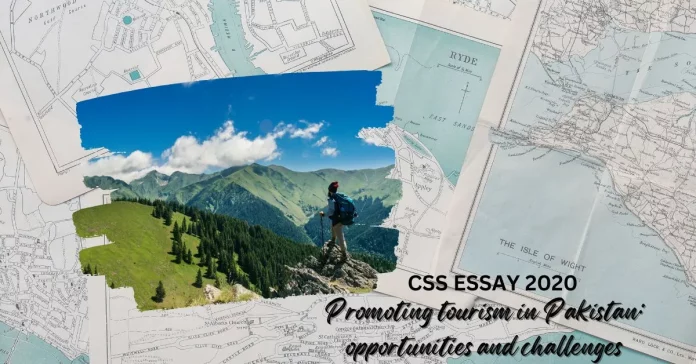Table of Contents
Introduction
Tourism has emerged as a significant economic sector worldwide, contributing to economic growth, job creation, and cultural exchange. In the case of Pakistan, a country rich in natural beauty, historical heritage, and cultural diversity, tourism presents a promising avenue for economic development. However, the promotion of tourism in Pakistan is not without its challenges. This essay explores the opportunities and challenges of promoting tourism in Pakistan and highlights the importance of leveraging its potential for sustainable growth.
Exposition
A. Definition of tourism and its importance
To understand the significance of promoting tourism in Pakistan, it is essential to first define tourism and recognize its global impact. Tourism refers to the travel and exploration of destinations for leisure, business, or cultural purposes. It plays a vital role in fostering economic growth, job creation, and cross-cultural understanding.
B. Unique attractions and natural beauty of Pakistan
Pakistan, with its diverse landscapes ranging from majestic mountain ranges to ancient archaeological sites and bustling cities, possesses immense tourism potential. Its natural beauty, including the serene valleys of Northern Pakistan, the coastal areas along the Arabian Sea, and the deserts of Thar, offers unique attractions for both domestic and international tourists. Furthermore, Pakistan’s rich historical and cultural heritage, including UNESCO World Heritage sites such as Taxila, Lahore Fort, and Mohenjo-Daro, adds to its allure.
Challenges in Promoting Tourism in Pakistan
A. Security concerns and negative perception
Despite its vast potential, there are several challenges that hinder the promotion of tourism in Pakistan. The foremost challenge is the negative perception associated with security concerns. International media coverage often highlights security issues, leading to a distorted image of the country. Addressing these concerns and improving the perception of Pakistan as a safe and welcoming tourist destination is crucial.
B. Lack of infrastructure and amenities
Additionally, inadequate infrastructure, including transportation, accommodation, and amenities, poses a challenge for tourism development. Limited international connectivity and the lack of direct flights from major tourist markets limit accessibility to Pakistan. To overcome these challenges, significant investment in infrastructure development is required.
Opportunities for Promoting Tourism in Pakistan:
A. Government initiatives and policies
Despite the challenges, there are substantial opportunities for promoting tourism in Pakistan. The government has recognized the importance of tourism as an economic driver and has implemented initiatives and policies to facilitate its growth. These include the introduction of e-visas, the establishment of tourism development authorities, and the promotion of special tourist zones.
B. Investment in infrastructure development
Investment in infrastructure development, including the construction of highways, airports, and hospitality facilities, is vital for attracting tourists. Improved connectivity through better road networks, the expansion of international airports, and the development of tourist-friendly transportation services can enhance accessibility and visitor experience.
C. Cultural and heritage tourism
Pakistan’s cultural and heritage tourism potential is a significant opportunity for attracting international tourists. The country’s diverse cultural heritage, including vibrant festivals, traditional crafts, and indigenous communities, offers unique experiences for travelers. By promoting cultural tourism, Pakistan can showcase its rich history, traditions, and hospitality, while also generating economic opportunities for local communities.
D. Adventure tourism and ecotourism
Adventure tourism and ecotourism are emerging sectors that present tremendous potential for Pakistan. The country’s mountainous regions, such as the Karakoram and Himalayan ranges, offer opportunities for trekking, mountaineering, and skiing. The promotion of sustainable practices and the preservation of natural resources are essential to ensure the long-term viability of adventure tourism and protect the pristine environment.
Argumentation
A. Economic benefits of tourism
Promoting tourism in Pakistan brings numerous benefits that extend beyond the economic realm. Economically, tourism stimulates job creation and provides employment opportunities for local communities. It also contributes to foreign exchange earnings, which can strengthen the national economy. By diversifying the economy through tourism, Pakistan can reduce its reliance on traditional sectors and promote inclusive growth.
B. Social and cultural benefits of tourism
Socially and culturally, tourism plays a pivotal role in preserving and promoting the country’s cultural heritage. It provides opportunities for the revitalization of historical sites, traditional crafts, and indigenous knowledge. Tourism also fosters inter-cultural exchange, promoting mutual understanding and appreciation among diverse communities. It enhances the quality of life for local communities by generating income, improving infrastructure, and supporting social development projects.
C. Environmental benefits of sustainable tourism
Furthermore, sustainable tourism practices can have significant environmental benefits. Responsible tourism promotes the conservation of natural resources, encourages the protection of biodiversity, and raises awareness of environmental issues. By promoting eco-friendly practices, Pakistan can preserve its natural wonders for future generations and position itself as a leader in sustainable tourism.
Description
A. Tourist attractions in different regions of Pakistan
Pakistan offers a plethora of tourist attractions across different regions. The Northern areas, including Gilgit-Baltistan and Khyber Pakhtunkhwa, boast breathtaking landscapes, such as the majestic peaks of K2 and Nanga Parbat, picturesque valleys like Hunza and Swat, and pristine lakes like Saif-ul-Malook and Attabad. The coastal areas along the Arabian Sea, including Karachi and Gwadar, offer beautiful beaches, water sports, and historical sites. The ancient cities of Lahore and Multan showcase architectural marvels, vibrant bazaars, and cultural festivals. Accommodation options range from luxury hotels to guesthouses and eco-lodges, catering to the diverse needs of tourists.
Narration
A. Success stories of tourism promotion in Pakistan
Success stories from different regions of Pakistan demonstrate the positive impact of tourism promotion. The development of tourist destinations such as Hunza and Swat has brought economic prosperity to local communities through increased employment opportunities and income generation. The revival of cultural festivals, such as the Shandur Polo Festival and the Kalash Spring Festival, has not only attracted tourists but also rejuvenated local cultural traditions. These examples highlight the transformative power of tourism in Pakistan.
Conclusion
Promoting tourism in Pakistan is a pathway to sustainable economic growth, cultural preservation, and environmental conservation. By addressing security concerns, investing in infrastructure development, and leveraging its cultural and natural assets, Pakistan can unlock the full potential of its tourism industry. The government, private sector, and local communities must work together to create an enabling environment that attracts tourists, preserves cultural heritage, and protects the environment. Through strategic planning, collaboration, and sustainable practices, Pakistan can position itself as a desirable and responsible tourist destination on the global stage.
















